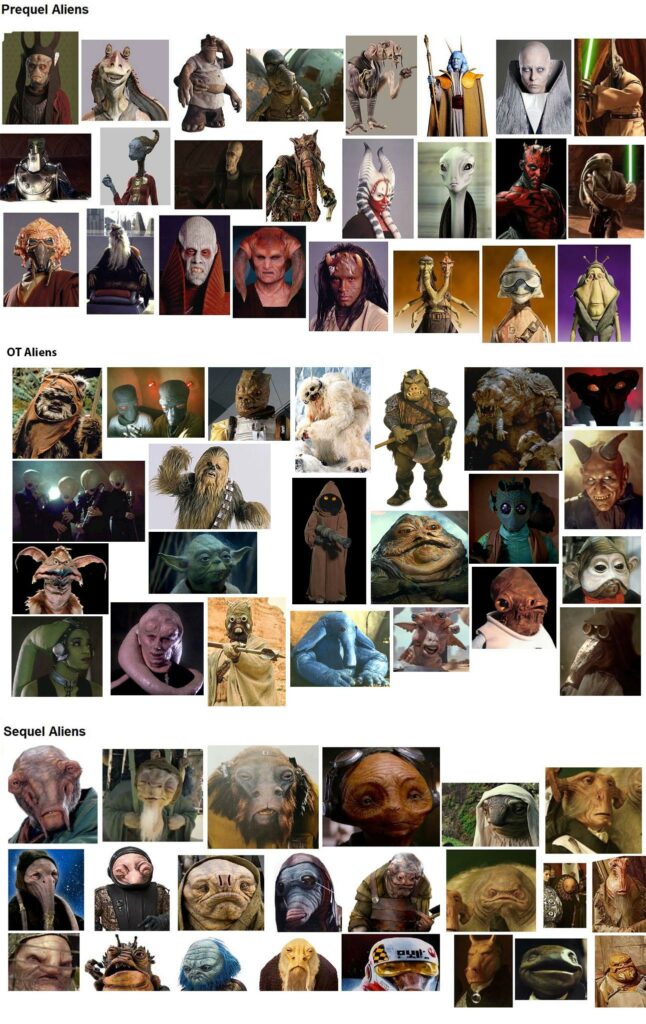Why Do All Aliens In Star Wars Have Faces?

Header Image: Three Tusken Raider cosplayers sitting on the steps outside the Adler Planetarium for the 2014 Adler After Dark: Geek Chic event.
As we were preparing to celebrate Star Wars Day, Adler Astronomer Dr. Geza Gyuk raised a very interesting scientific question about the Star Wars universe: Why do all the aliens in Star Wars have faces? We asked him what he meant by that. This was his reply!

“Well, a ‘face’ is pretty much a portion of the body of a creature where there is a mouth and eyes. We have faces, and most vertebrates and even a lot of invertebrates have faces of sorts, but plenty of creatures on Earth don’t…sponges, hydra, clams, jellyfish, etc.
So, one would expect that completely unrelated evolutionary creatures would not have faces…maybe they have totally different ways of sensing, or they have eyes that are not near their mouths…or don’t really have mouths at all.
Some of this is more plausible than others; not having a mouth is probably unlikely for aliens that are complex enough to be intelligent. The ability to put high grade organic material inside of yourself for intensive processing over time while you do other things, is very efficient.
And it makes a lot of sense to have sophisticated sensory organs near the mouth. After all, you want to know what you are putting inside of yourself. High grade organic material—also known as food—sometimes fights back!
All of the mouths in Star Wars appear to be horizontal with vertical jaw motion. Even here on Earth plenty of animals (like insects) have vertical mouths with horizontal mandibles.

Some more thoughts on faces: nerve impulses travel at a maximum of about 120 m/s, which is slower than the speed of sound or light. That means it is optimal to have your sound or light sensors (“ears” or “eyes”) close to your brain. If evolution also favors having the primary senses close to the mouth (to monitor what you put into your mouth), then that would suggest that faces in front of the brain are common. Certainly evolution will encourage having a chemical sense associated with the mouth (to avoid self-poisoning from bad food) and as a short pathway between the chemical sense and the brain to allow rejection of food before it is swallowed.
All this suggests that for creatures with “nerve” speeds similar to our own face makes sense: an aperture to the gut, coupled with eyes nearby to monitor what goes in and to aid in positioning the mouth to “take a bite”. Ears would be nearby simply because they also have to be near the brain.
But, this assumes a few things. First, that the nerve speeds are broadly similar to ours. Imagine an organism where nerve impulses are carried in a way much more like electrical signals in wires—more like 100,000,000 m/s. It wouldn’t probably matter where the “ears” or “eyes” were. In fact, for “ears” it wold be best to have them at the extremities. You’d hear the sounds as soon as possible!
Second, imagine a species that lives in total darkness, or in very muddy water or cloud saturated air. It might not make any sense to have eyes at all. Hearing and echolocation/ultrasound sense might be much more useful.
If you combined this with faster nerve speeds, then the optimal configuration might be to have a mouth at the end of a protrusion—like a tentacle—with other protrusions with the hearing/echolocation/ultrasound sensors deployed around. Think of a squid or something with a mouth at the end of a perhaps somewhat stumpy tentacle, and then the other tentacles with sensors. These creatures would be constantly generating a 3-D model of the world from the input of the “tentacle ears”, most detailed close in, especially around the mouth, but extending much farther out.
Since sound waves travel through the flesh or water interface pretty well—think dolphin echolocation—the sensors might not look like much on the skin surface. So the “face” might consist only of a mouth with no discernible eyes, ears, etc. The tentacle mouth maybe would be circular and more like with a grinding plate dentation, and would dart around to eat food. I don’t think we would consider that a face.”
The Space Comedy Show You Need Right Now
Are we alone in the universe? Every day, astrobiologists look up at stars, exoplanets, and galaxies searching for answers! Sing along to this song from the Adler Planetarium’s space comedy show Wow! Signal and remember, it’s never aliens (until it is)!






